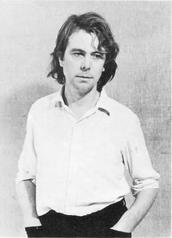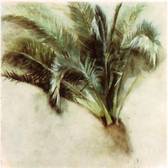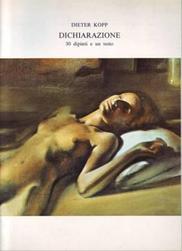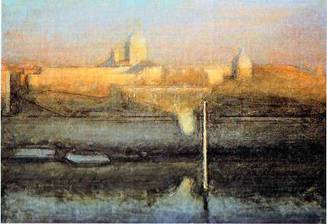Critical Reception
 Dieter Kopp, 1970s
Dieter Kopp, 1970s
In the late 1950s, when Dieter Kopp was studying art in Munich and Paris, students were encouraged to paint in the early 20th-century style: Van Gogh, Léger, Cubism, and Kandinsky’s first abstract paintings were in vogue, and little emphasis was placed on draftsmanship. For a young artist interested in figuration this meant that the approved models were of little use in forming a personal representational style. Kopp’s work in this early period was somewhat experimental, including paintings whose nebulous shapes recalled the sky in El Greco’s view of Toledo. As Kopp later recalled, it was in fact through El Greco that he rediscovered Renaissance art: if, at the turn of the century, El Greco had helped bridge the gap between Renaissance and modern art, in the 1950s it was through El Greco that Kopp found his way back to the world of Tintoretto, Titian, Giorgione, Mantegna—artists who at the time were less valued than Giotto and the “Primitive” Italian painters.
 Palm, watercolor, 1963
Palm, watercolor, 1963
Kopp soon moved to Florence. Having rejected the loose imitation of modern artists in favor of a self-imposed, rigorous figurative training, in the early 1960s he visited the Uffizi constantly, “re-learning” how to draw and slowly returning to painting, especially after his move to Rome in 1966.
His first solo show in Rome, at the Galleria La Nuova Pesa, came in 1974, and caused some controversy owing to the artist’s polemical defense, in the show’s catalogue, of representational art as the answer to what he perceived as the exhaustion of the strain of modern art that had emerged in the early 20th century.
Kopp’s statement that “Modern art has taught us to break with tradition; this must teach us to break with the tradition of modern art” would resonate: architectural historian Paolo Portoghesi cited it in his After Modern Architecture (1980), as did Jean Clair, then curator at the Centre Pompidou in Paris, in his 1983 Considérations sur l’état des beaux-arts. That Kopp’s work, and not only his words, was thought of as pointing a way forward, was confirmed when critic John Hart, writing in the Daily American in 1976, asserted that his realism was “vanguard art of today and a foundation for the art of tomorrow. We certainly need it.”
His first solo show in Rome, at the Galleria La Nuova Pesa, came in 1974, and caused some controversy owing to the artist’s polemical defense, in the show’s catalogue, of representational art as the answer to what he perceived as the exhaustion of the strain of modern art that had emerged in the early 20th century.
Kopp’s statement that “Modern art has taught us to break with tradition; this must teach us to break with the tradition of modern art” would resonate: architectural historian Paolo Portoghesi cited it in his After Modern Architecture (1980), as did Jean Clair, then curator at the Centre Pompidou in Paris, in his 1983 Considérations sur l’état des beaux-arts. That Kopp’s work, and not only his words, was thought of as pointing a way forward, was confirmed when critic John Hart, writing in the Daily American in 1976, asserted that his realism was “vanguard art of today and a foundation for the art of tomorrow. We certainly need it.”
 Kopp, "Dichiarazione," 1982
Kopp, "Dichiarazione," 1982
In 1982, for a show at the Galleria Giulia in Rome, Kopp again issued a “declaration” prefacing the catalogue of the exhibited works. As epigraph, he chose Baudelaire’s description of the “positivist” artist’s credo (from the “Salon of 1859”): “I want to represent things as they are; or rather, as they would be, supposing that I did not exist.” Critics have debated whether Kopp’s work does in fact reflect this view, some finding his early paintings clinical, even hyperrealist, while others have spoken of Kopp’s “humanism” and “romanticism.” For the latter, Kopp’s art would appear closer to Baudelaire’s “imaginative” artist’s intent: “I want to illuminate things with my mind, and to project their reflection upon other minds.”
Reviewing Kopp’s show at the Galleria dell’Oca in 1985, Vittorio Sgarbi, for example, wrote of Kopp’s landscapes that they are “landscapes of the mind, thought projections, not derived from reality,” and concluded that “such paintings represent the threshold between being and appearing.”
Reviewing Kopp’s show at the Galleria dell’Oca in 1985, Vittorio Sgarbi, for example, wrote of Kopp’s landscapes that they are “landscapes of the mind, thought projections, not derived from reality,” and concluded that “such paintings represent the threshold between being and appearing.”
 Lungotevere, sunset, 2000
Lungotevere, sunset, 2000
Here, he was addressing a question raised in “Idea of Glory,” the essay that Giorgio Agamben had suggested would be an appropriate introduction to the show’s catalogue. As though to help us explore the difficulty of distinguishing between things painted “as they are” and their imaginative projection by the artist on other minds, Agamben noted that unlike animals, “Only man is concerned with images as images; only man knows appearance as appearance.” Hence, paradoxically, “For us alone things are; only for us are things set free from our needs and from our immediate relation with them. They are: simply, marvelously, ungraspably.”
Although Kopp’s style has gradually become freer, less “obsessive” (as one critic characterized it in 1982), his work still evokes this search for the ungraspable nature of things. Terms such as “mystery,” “magic,” “timelessness,” recur in the criticism. When a large exhibition in 1988 at the Istituto Nazionale della Grafica in Rome grouped works by Kopp with those of William Bailey and Ivan Theimer, one term employed both by Giuliano Briganti and Mario Quesada in the catalogue was “silence.” Critics often contrasted the loud, voluble quality of much contemporary art with the quiet intensity of Kopp’s images, and in 2000, Jean Clair’s introduction to a show at the Galleria Carlo Virgilio spoke of works that, when one looks at them, “look back” at us: they gradually establish their presence, capturing our attention permanently rather than momentarily. He explained this effect by remarking that Kopp’s work, rather than being “timeless,” as some critics had maintained, in fact comes to us through time, the result of the dense layering of artistic knowledge accumulated through centuries.
Bibliography
Texts by Dieter Kopp
“Appunti di lavoro,” in catalogue for La Nuova Pesa solo show, 1974
Dichiarazione: 30 dipinti e un testo, in catalogue for Galleria Giulia show, 1982
“Appunti di lavoro,” in catalogue for La Nuova Pesa solo show, 1974
Dichiarazione: 30 dipinti e un testo, in catalogue for Galleria Giulia show, 1982
Illustrated books and articles
Stefano Malatesta, “Passeggiate con visioni,” Nuovi Argomenti, April-June 2005
Dieter Kopp, Ciotole (Roma: Andrea Franchi, 2001)
Dieter Kopp, Palme (Roma: Andrea Franchi, 2009)
Dieter Kopp, Fiori (Roma: Andrea Franchi, 2011)
Irene de Guttry, Dieter Kopp, Ara Pacis: undici tra oli, tempere, acquerelli della teca di Vittorio Morpurgo (Roma: Andrea Franchi, 2011)
Dieter Kopp, Frutti (Roma: Andrea Franchi, 2011)
Dieter Kopp, Punte d’oro e d’argento (Roma: Andrea Franchi, 2011)
Stefano Malatesta, “Passeggiate con visioni,” Nuovi Argomenti, April-June 2005
Dieter Kopp, Ciotole (Roma: Andrea Franchi, 2001)
Dieter Kopp, Palme (Roma: Andrea Franchi, 2009)
Dieter Kopp, Fiori (Roma: Andrea Franchi, 2011)
Irene de Guttry, Dieter Kopp, Ara Pacis: undici tra oli, tempere, acquerelli della teca di Vittorio Morpurgo (Roma: Andrea Franchi, 2011)
Dieter Kopp, Frutti (Roma: Andrea Franchi, 2011)
Dieter Kopp, Punte d’oro e d’argento (Roma: Andrea Franchi, 2011)
Catalogue introductions and other writings
Antonello Trombadori, “La luce dei Nazareni,” in catalogue for La Nuova Pesa show, 1974
Gustav René Hocke, “Geheimbotschaften im Erkennbaren,” in catalogue for Galerie Orny show, 1978
Giorgio Agamben, “Idea della gloria,” in catalogue for Galleria dell’Oca show, 1985
Giorgio Soavi, Il quadro che mi manca (Milano: Garzanti, 1986)
Giuliano Briganti, “Filausonia,” in catalogue for Istituto Nazionale per la Grafica show, 1988
Mario Quesada, “Dieter Kopp,” in catalogue for Istituto Nazionale per la Grafica show, 1988
Ines Millesimi, “Kopp, Dieter,” in Carlo Pirovano, ed., La pittura in Italia: il novecento (Milano: Mondadori Electa, 1992), vol. 2
Giuliano Briganti, in catalogue for Galleria Forni show, 1994
Fabrizio D’Amico, in catalogue for Galleria Forni show, 1994
Jean Clair, “Praesens / Absens,” in catalogue for Galleria Carlo Virgilio show, 2000
Bruno Caruso, in catalogue for Galleria Elle Arte show, 2002
Stefano Malatesta, in catalogue for Galleria Elle Arte show, 2002
Fillide Melandroni [Monica Ferrando], “Ciotola cinese di Dieter Kopp,” De Pictura, 25 March 2013
Antonello Trombadori, “La luce dei Nazareni,” in catalogue for La Nuova Pesa show, 1974
Gustav René Hocke, “Geheimbotschaften im Erkennbaren,” in catalogue for Galerie Orny show, 1978
Giorgio Agamben, “Idea della gloria,” in catalogue for Galleria dell’Oca show, 1985
Giorgio Soavi, Il quadro che mi manca (Milano: Garzanti, 1986)
Giuliano Briganti, “Filausonia,” in catalogue for Istituto Nazionale per la Grafica show, 1988
Mario Quesada, “Dieter Kopp,” in catalogue for Istituto Nazionale per la Grafica show, 1988
Ines Millesimi, “Kopp, Dieter,” in Carlo Pirovano, ed., La pittura in Italia: il novecento (Milano: Mondadori Electa, 1992), vol. 2
Giuliano Briganti, in catalogue for Galleria Forni show, 1994
Fabrizio D’Amico, in catalogue for Galleria Forni show, 1994
Jean Clair, “Praesens / Absens,” in catalogue for Galleria Carlo Virgilio show, 2000
Bruno Caruso, in catalogue for Galleria Elle Arte show, 2002
Stefano Malatesta, in catalogue for Galleria Elle Arte show, 2002
Fillide Melandroni [Monica Ferrando], “Ciotola cinese di Dieter Kopp,” De Pictura, 25 March 2013
Select press reviews
“Berenice,” “A Roma Kopp, ‘Nazzareno,’” Paese Sera, 18 April 1974
John Hart, “Dieter Kopp’s imagery a correction for faulty vision,” Daily American, 18 April 1974
Arturo Bovi, “Kopp,” Il Messaggero, 28 April 1974
Dario Micacchi, “Il freddo mediterraneo di Kopp,” L’Unità, 30 April 1974
Bruno Morini, “Le palme e i sassi di Dieter Kopp,” Giornale d’Italia, 2-3 May 1974
Lorenza Trucchi, “Kopp alla Nuova Pesa,” Momento Sera, 2-3 May 1974
Duilio Morosini, “Il Manifesto del giovane Kopp,” Paese Sera, 4 May 1974
Edith Schloss, “Around the European Galleries: Rome,” International Herald Tribune, 23-24 May 1974
John Hart, in Daily American, 8 April 1976
Edith Schloss, in International Herald Tribune, 10-11 April 1976
Gino Visentini, in Il Messaggero, 16 April 1976
John Hart, “Kopp’s vanguard art of today,” Daily American, 17 April 1976
Enzo Siciliano, “E’ancora arte degli Anni 60?” La Stampa, 22 April 1976
Franco Simongini, “Le fanciulle in penombra di Dieter Kopp,” Il Tempo, 15 March 1982
Dario Micacchi, “Dentro il ‘mistero’ della quotidianità,” L’Unità, 18 March 1982
Luigi Lambertini, “Dieter Kopp: Luci levigate e silenzio,” Il Giornale, 19 March 1982
La Repubblica, 19 March 1982
Enzo Bilardello, in Corriere della Sera, 30 March 1982
Fabrizio D’Amico, “Kopp e la sua ‘magna charta,’” La Repubblica, 31 March 1982
Antonello Trombadori, “Quanta coerenza in quell Cézanne!” L’Europeo, 5 April 1982
Paolo Baroni, “Sedici artisti romani fanno girare a Jesi la ruota del presente,” L’Unità, 3 August 1982
Dario Micacchi, “Dieter Kopp: tradizione moderna di pittura di luce,” L’Unità, 10 May 1985
Luisa Mosello, “Il senso di una ricerca,” Tribuna Politica, 10 May 1985
Vittorio Sgarbi, “Soltanto una questione di stile,” L’Europeo, 11 May 1985
Vito Apuleio, “Dieter Kopp: L’ossessione del motivo,” Il Messaggero, 14 May 1985
Franco Simongini, “Spleen a Parigi,” Il Tempo, 15 May 1985
Enzo Scotto Lavina, in Il Giornale di Napoli, 17 May 1985
Enzo Bilardello, “Dipinti di Dieter Kopp,” Corriere della Sera, 20 May 1985
Antonio Mercadante, “Il tono magico di Dieter Kopp,” L’Umanità, 20 May 1985
Claudio Verna, “Nuovo modo di fare arte,” Arte, May 1985
Vittorio Sgarbi, “Le daremo un posto in galleria,” L’Europeo, 6 September 1986
Elena Pontiggia, in Il Giornale Nuovo, 14 September 1986
Linda de Sanctis, “Italia, un’attrazione fatale,” La Repubblica, 2 March 1988
Carolyn Christov Bakargiev, “Nostalgia per il classico,” Il Sole 24 Ore, 6 March 1988
Lorenza Trucchi, “Un trio ben affiatato,” Il Giornale, 6 March 1988
Guido Almansi, “Trittico per l’Italia,” La Repubblica, 12 March 1988
Vittorio Sgarbi, “Con occhi stranieri,” L’Europeo, 1 april 1988
Mario Quesada, “Paesaggi senza figure,” La Repubblica, 10 May 1994
Filippo Cardinale, “I paesaggi agrigentini sulle tele di Kopp,” La Sicilia, 1 October 2002
Stefano Malatesta, “Paesaggi e segreti,” La Repubblica, 11 November 2002
Filippo Cardinale, “Il male di Sicilia di un artista tedesco,” La Sicilia, 20 November 2002
Aldo Gerbino, “Dieter Kopp, religiosa appartenenza al mondo,” La Gazzetta del Sud, 22 November 2002
Mario Perniola, Roberto Terrosi, “L’arte di stare fuori dal mondo” (interview), L’Unità, 20 September 2003
Elisabetta Rasy, “Kopp di là dal fiume,” Corriere della Sera, 6 December 2006
“Berenice,” “A Roma Kopp, ‘Nazzareno,’” Paese Sera, 18 April 1974
John Hart, “Dieter Kopp’s imagery a correction for faulty vision,” Daily American, 18 April 1974
Arturo Bovi, “Kopp,” Il Messaggero, 28 April 1974
Dario Micacchi, “Il freddo mediterraneo di Kopp,” L’Unità, 30 April 1974
Bruno Morini, “Le palme e i sassi di Dieter Kopp,” Giornale d’Italia, 2-3 May 1974
Lorenza Trucchi, “Kopp alla Nuova Pesa,” Momento Sera, 2-3 May 1974
Duilio Morosini, “Il Manifesto del giovane Kopp,” Paese Sera, 4 May 1974
Edith Schloss, “Around the European Galleries: Rome,” International Herald Tribune, 23-24 May 1974
John Hart, in Daily American, 8 April 1976
Edith Schloss, in International Herald Tribune, 10-11 April 1976
Gino Visentini, in Il Messaggero, 16 April 1976
John Hart, “Kopp’s vanguard art of today,” Daily American, 17 April 1976
Enzo Siciliano, “E’ancora arte degli Anni 60?” La Stampa, 22 April 1976
Franco Simongini, “Le fanciulle in penombra di Dieter Kopp,” Il Tempo, 15 March 1982
Dario Micacchi, “Dentro il ‘mistero’ della quotidianità,” L’Unità, 18 March 1982
Luigi Lambertini, “Dieter Kopp: Luci levigate e silenzio,” Il Giornale, 19 March 1982
La Repubblica, 19 March 1982
Enzo Bilardello, in Corriere della Sera, 30 March 1982
Fabrizio D’Amico, “Kopp e la sua ‘magna charta,’” La Repubblica, 31 March 1982
Antonello Trombadori, “Quanta coerenza in quell Cézanne!” L’Europeo, 5 April 1982
Paolo Baroni, “Sedici artisti romani fanno girare a Jesi la ruota del presente,” L’Unità, 3 August 1982
Dario Micacchi, “Dieter Kopp: tradizione moderna di pittura di luce,” L’Unità, 10 May 1985
Luisa Mosello, “Il senso di una ricerca,” Tribuna Politica, 10 May 1985
Vittorio Sgarbi, “Soltanto una questione di stile,” L’Europeo, 11 May 1985
Vito Apuleio, “Dieter Kopp: L’ossessione del motivo,” Il Messaggero, 14 May 1985
Franco Simongini, “Spleen a Parigi,” Il Tempo, 15 May 1985
Enzo Scotto Lavina, in Il Giornale di Napoli, 17 May 1985
Enzo Bilardello, “Dipinti di Dieter Kopp,” Corriere della Sera, 20 May 1985
Antonio Mercadante, “Il tono magico di Dieter Kopp,” L’Umanità, 20 May 1985
Claudio Verna, “Nuovo modo di fare arte,” Arte, May 1985
Vittorio Sgarbi, “Le daremo un posto in galleria,” L’Europeo, 6 September 1986
Elena Pontiggia, in Il Giornale Nuovo, 14 September 1986
Linda de Sanctis, “Italia, un’attrazione fatale,” La Repubblica, 2 March 1988
Carolyn Christov Bakargiev, “Nostalgia per il classico,” Il Sole 24 Ore, 6 March 1988
Lorenza Trucchi, “Un trio ben affiatato,” Il Giornale, 6 March 1988
Guido Almansi, “Trittico per l’Italia,” La Repubblica, 12 March 1988
Vittorio Sgarbi, “Con occhi stranieri,” L’Europeo, 1 april 1988
Mario Quesada, “Paesaggi senza figure,” La Repubblica, 10 May 1994
Filippo Cardinale, “I paesaggi agrigentini sulle tele di Kopp,” La Sicilia, 1 October 2002
Stefano Malatesta, “Paesaggi e segreti,” La Repubblica, 11 November 2002
Filippo Cardinale, “Il male di Sicilia di un artista tedesco,” La Sicilia, 20 November 2002
Aldo Gerbino, “Dieter Kopp, religiosa appartenenza al mondo,” La Gazzetta del Sud, 22 November 2002
Mario Perniola, Roberto Terrosi, “L’arte di stare fuori dal mondo” (interview), L’Unità, 20 September 2003
Elisabetta Rasy, “Kopp di là dal fiume,” Corriere della Sera, 6 December 2006